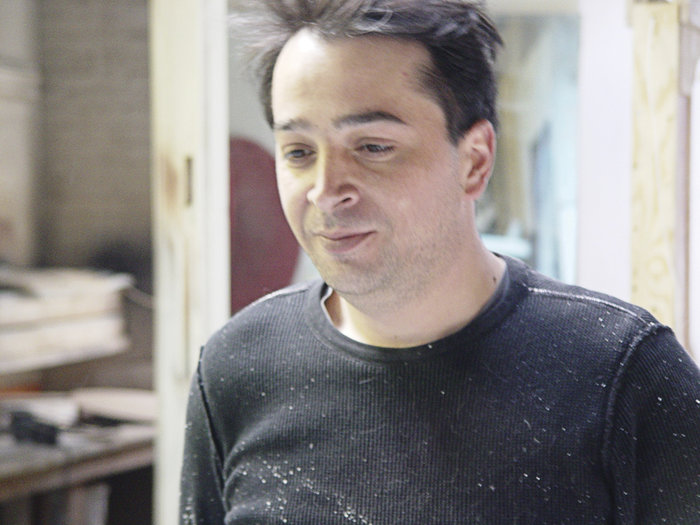Artist Gunes Akseki strolled triumphantly, though a tad wearily, around his eight-by-eight-by-four-foot sculpted amalgam of the classic symbols for male and female. As if resting after its hard-earned and much-acclaimed debut during the 2012 International Art Expo on March 23 in Manhattan, the piece lay beneath a blanket in the garage adjacent to Akseki’s Union City studio, Monumental Sculpture.
Though the piece may have earned a moment of repose, Akseki and his conceptual consultant, Edward S. Majian, have only just begun. After a several-year hiatus from the studio art scene, Akseki has come back to public sculpture with a vengeance and a renewed focus that has already begun to make its mark on the art world.
“There should always be a kind of connection [between art and community]. You cannot create something out of nothing.” – Gunes Akseki
____________
Akseki even has plans for sculptures in his “beloved” Union City.
“The environment does not wholly determine my art, of course; I do that,” Akseki explained. “But there should always be a kind of connection. You cannot create something out of nothing.”
Symbolic gesture
With the Art Expo piece, simply entitled “Male and Female,” Akseki took two opposing two-dimensional symbols and created an organic, three-dimensional form that challenges conventional ideas of gender while showing the public how two otherwise flat symbols translate in a physical space.
“He takes basic two-dimensional images and exposes them to each other,” Majian said. “It’s so direct because it’s male and female, yet in a way it sums up all of humanity. It’s so basic and yet so profoundly complicated.”
While Akseki borrows two highly-charged societal symbols for the subject of his sculpture, he allows the public to come away with their own interpretations. This unwillingness to subject his viewing public to the usual stereotypes even extends to his cat.
“This is Kitty,” Akseki said, as his tortoise rescue jumped onto his shoulder. “You see, in Turkey, Kitty means cat.”
He chuckled, but the name actually was the product of a week-long discussion, according to Majian.
“He didn’t want to impose an ideology on the identity of his cat,” Majian said.
Fruits of the earth
Akseki has been taking his artistic cues from his environment since he was six years old; though much more literally back then. He grew up in Istanbul, Turkey, where his artist father Sakir taught him how to create his own clay from the ground.
Akseki would often travel miles to a graveyard where he collected the earth he would later strain and sculpt into little animals. Even then, his childhood artwork took on a symbolic importance as he molded replicas of living things out of clay that once surrounded the dead.
“My father died early, when I was 20,” Akseki said, “but he was such a great character for me.”
Akseki went on to attend the prestigious Istanbul Art Academy, selected from a pool of 7,000.
“It’s different in Turkey than here,” he said. “To get in, you have to have the ability, not the money.”
He excelled and exhibited his paintings, stone carvings, and sculptures; worked on commission, for himself, and for galleries. He opened his Union City studio three years ago in order to accommodate the, well, monumental proportions of his newest artistic vision.
“I choose to be a public artist, not a studio artist,” Akseki explained, “because studio sculptures are made for galleries and are limiting in size.”
“He tries to tap into people’s subconscious with symbols, and affect and shape the social landscape as a result,” Majian said. “His art is suited to its unique environment, but not dictated by it.”
Monumental exposure
“Male and Female” hung three feet high above the heads of the Art Expo patrons in the lobby of the exhibition space. Some stood and stared, some kissed beneath it, and some hardly noticed it at all because of the way it suited its space.
Compared to the works of other artists confined to booths, it was not just a show piece, Majian said. It was made for the space as part of the space.
It was a monumental piece, but not just in size. The effort to get it up there was monumental as well. They arrived at Pier 92 at 4 p.m. on Wednesday to find the sculpture had arrived in pieces.
“It was not just broken, it was very broken,” Majian said. “Under Gunes’ direction, everybody worked all night together to fix it.” They finally had it up on Thursday at 9:30 a.m.
The show opened at 10.
“It was nearly unimaginable that this would get done,” Majian said, but it did. “It speaks to the fact that Gunes’ time had arrived.”
For the love of Union City
Akseki sees his home of three years as a community ripe for artistic expression.
“When I got here, I felt at home,” he said. “This is the perfect location for public art. People are close to you. They look in your eyes. I know everybody around me, and they know me too.”
Majian described how Akseki walks the Union City streets constantly and imagines what places could look like based on his work and vision as a sculptor. While there have been no formal proposals made with the city, Akseki has his sights set on Art Plaza and even the bridge above Interstate 495.
“I’m here forever,” Akseki said. “I’m not going to go anywhere, I feel like I owe something to this community.”
For more information on Akseki’s work, visit www.wearemonumental.com.
Gennarose Pope may be reached at gpope@hudsonreporter.com
